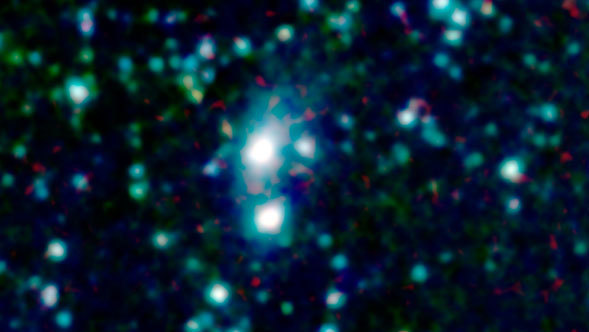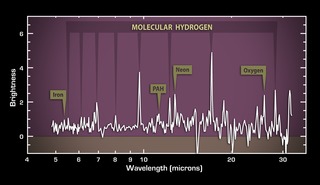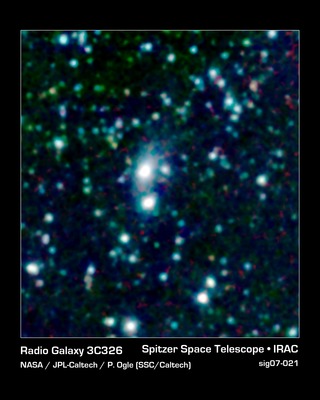
Credit: NASA/JPL-Caltech/P. Ogle (Spitzer Science Center/Caltech)
Chart • October 22nd, 2007 • sig07-020
sig07-020
This plot of data from NASA's Spitzer Space Telescope reveals vast reservoirs of hot gas in a galaxy about a billion light-years away called 3C 326 North. The gas is hot both figuratively and literally: it was stolen from another galaxy, and, during its transfer from one galaxy to another, it was heated up to hot-lava temperatures as high as 730 degrees Celsius (1,340 degrees Fahrenheit).
The data were taken by Spitzer's infrared spectrometer, which splits light apart into its constituent wavelengths much like a prism turns sunlight into a rainbow. The resulting bumps and wiggles shown here, called a spectrum, reveal the signature, or "fingerprint," of a hot, molecular hydrogen gas. In space, molecular hydrogen gas is a precious commodity: it is a necessary ingredient to make stars and planets. On Earth, this same gas is considered as a possible alternative fuel for cars.
The strength of the hydrogen fingerprint also tells astronomers that a lot is present in the galaxy the equivalent of one billion suns!
Astronomers were initially surprised to see so much gas because the galaxy is not busy making stars, as indicated by the weak signature in this spectrum of a star-forming molecule called polycyclic aromatic hydrocarbons. Further investigations revealed that the gas is being ripped off from a smaller, companion galaxy.
The weak signatures for neon, oxygen and iron in the spectrum indicate that the supermassive black hole at the center of this galaxy is relatively inactive, or sleepy.
About the Object
- Name
- 3C 326
- Type
- Galaxy > Type > Interacting
- Distance
- 1,000,000,000 Light Years
- Redshift
- 0.089
Color Mapping
| Band | Wavelength | Telescope |
| Infrared | Spitzer IRS |






